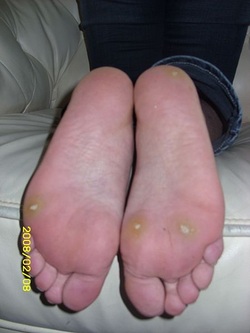Plantar Wart

A wart is a small growth of the skin caused by a virus. Warts are caused from direct contact to the human papilloma virus (HPV). The virus recruits blood vessels and nutrients from its host causing red or black dots (blood vessels) to the wart. The virus is only able to penetrate the epidermis or the top layer of skin.
Findings: Because the epidermis and dermis are locked together in a zipper like fashion (invagination) warts are often more painful with lateral or transverse compression versus direct pressure. Warts can either be solitary or closely clustered together (Mosaic). Common findings with warts include black spots or speckling, thickening of the skin, and pain with transverse compression greater than direct pressure, and are usually located in areas of pressure or micro trauma. The reason for susceptibility warts/viruses is not known. Plantar warts grow deep into the skin. Usually this growth occurs slowly, with the wart starting small and becoming larger over time.
Diagnosis: To diagnose a plantar wart, your foot and ankle doctor will likely remove the dead portion of the skin for better evaluation. After a few simple tests the diagnosis of a wart is usually easily made.
Treatment: treatment of a wart usually falls into a few broad categories:
It is important to note that there are many "old wives tales/remedies" regarding warts and the treatment of. Many of these treatments can cause potential harm and therefore it is best if they are avoided. Additionally, bathroom surgery or trying to remove the wart yourself should be strongly discouraged as this can cause significant wounds and potential for infection requiring further more aggressive treatment.
Findings: Because the epidermis and dermis are locked together in a zipper like fashion (invagination) warts are often more painful with lateral or transverse compression versus direct pressure. Warts can either be solitary or closely clustered together (Mosaic). Common findings with warts include black spots or speckling, thickening of the skin, and pain with transverse compression greater than direct pressure, and are usually located in areas of pressure or micro trauma. The reason for susceptibility warts/viruses is not known. Plantar warts grow deep into the skin. Usually this growth occurs slowly, with the wart starting small and becoming larger over time.
Diagnosis: To diagnose a plantar wart, your foot and ankle doctor will likely remove the dead portion of the skin for better evaluation. After a few simple tests the diagnosis of a wart is usually easily made.
Treatment: treatment of a wart usually falls into a few broad categories:
- Blistering agents- agents such as acids, liquid nitrogen/cryotherapy, and bases are applied to cause the superficial layer of the skin (epidermis) to separate itself from the underlying layer of skin by blistering isolating the virus and allowing for removal.
- Thermal destruction- laser therapy, electrodesiccation, and cautery work by burning superficial skin in a controlled manner after anesthesia is performed. This is then followed by curettage or removal of the top layer of skin.
- Antiviral agents- Imiquimods, 5 Florouricil, Podophylin, Carac are all agents or medications used to block of viral replication. Although painless they can be expensive
- Surgial excision- curettage, elipsation, saucerization, and excision are all ways of removing the skin via is surgical debridement.
It is important to note that there are many "old wives tales/remedies" regarding warts and the treatment of. Many of these treatments can cause potential harm and therefore it is best if they are avoided. Additionally, bathroom surgery or trying to remove the wart yourself should be strongly discouraged as this can cause significant wounds and potential for infection requiring further more aggressive treatment.